Team Contribution and Effectiveness: A Reflective Essay Analysis
VerifiedAdded on 2023/06/09
|8
|1990
|74
Essay
AI Summary
This reflective essay explores team effectiveness through an analysis of team contributions and critical incidents encountered during a semester-long project. The essay highlights the importance of theoretical knowledge in real-world application, emphasizing planning, collaboration, and leadership within the team. It delves into the team's dynamics, including the allocation of responsibilities, communication strategies, and conflict resolution methods. A critical incident involving SWOT analysis is discussed, showcasing how understanding individual strengths and weaknesses contributed to overall team success. The essay also addresses challenges such as time management and the absence of contingency plans, underscoring the significance of these elements in achieving team objectives. The conclusion reflects on the positive impact of teamwork, emphasizing the value of collaborative efforts and continuous evaluation in future professional endeavors. Desklib provides access to this and other solved assignments, offering valuable study resources for students.
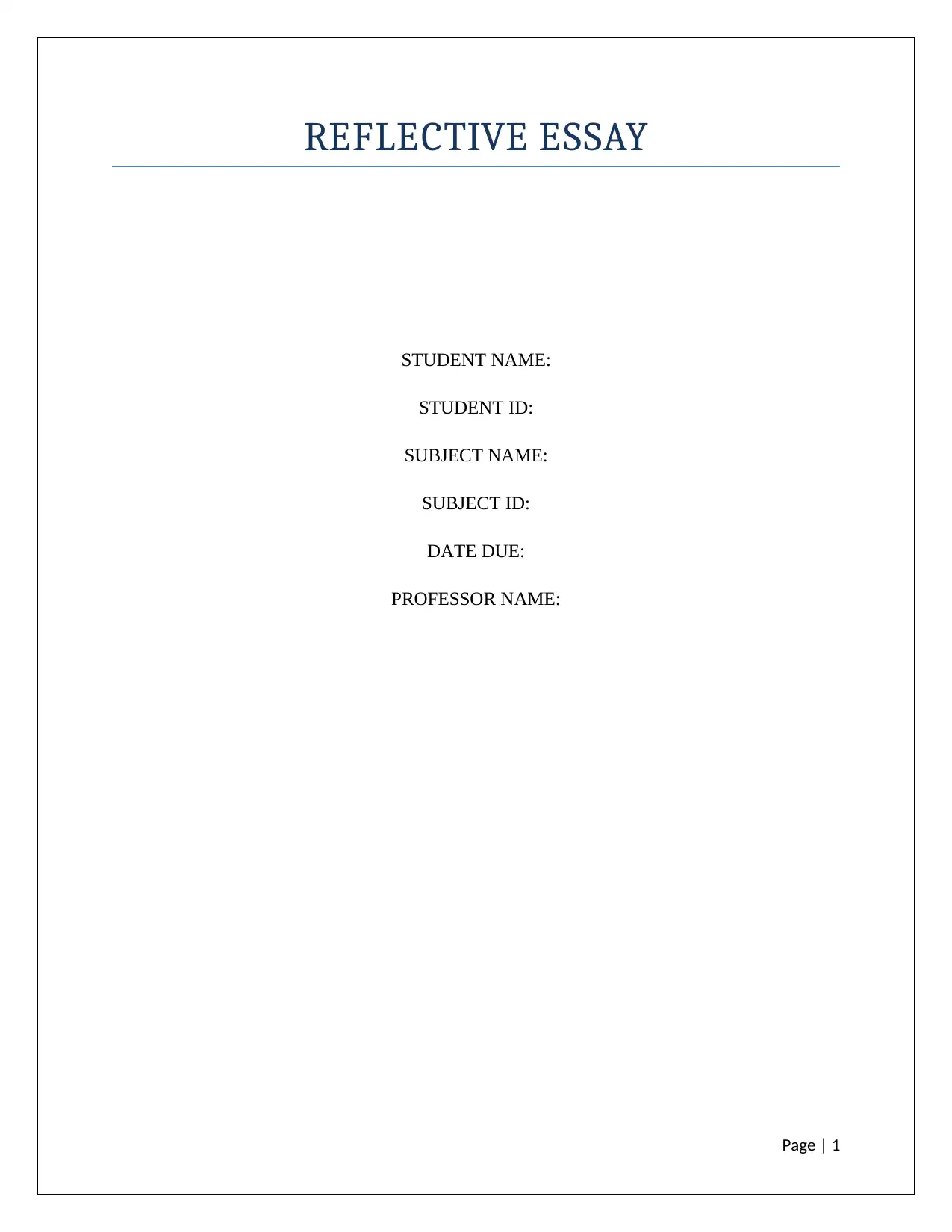
REFLECTIVE ESSAY
STUDENT NAME:
STUDENT ID:
SUBJECT NAME:
SUBJECT ID:
DATE DUE:
PROFESSOR NAME:
Page | 1
STUDENT NAME:
STUDENT ID:
SUBJECT NAME:
SUBJECT ID:
DATE DUE:
PROFESSOR NAME:
Page | 1
Paraphrase This Document
Need a fresh take? Get an instant paraphrase of this document with our AI Paraphraser
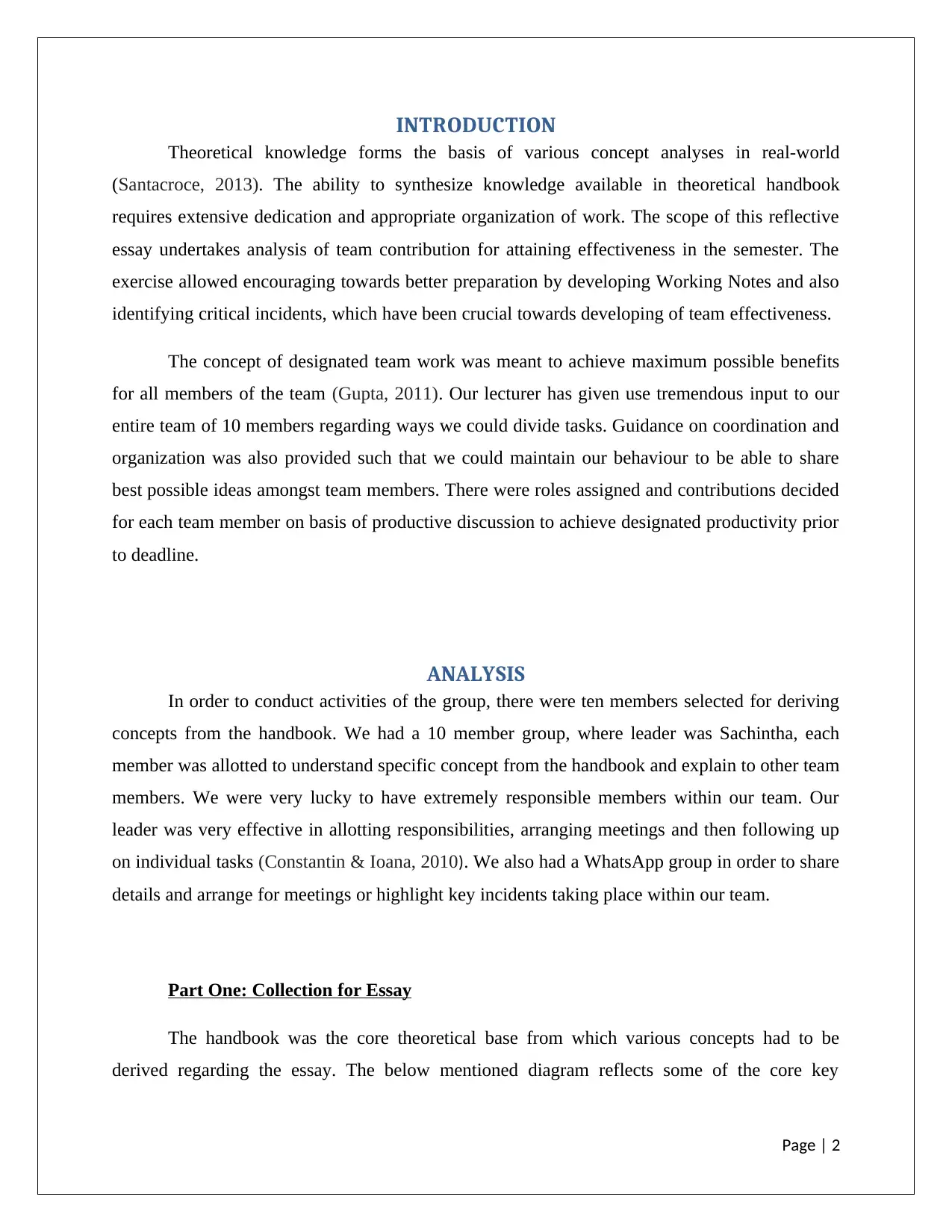
INTRODUCTION
Theoretical knowledge forms the basis of various concept analyses in real-world
(Santacroce, 2013). The ability to synthesize knowledge available in theoretical handbook
requires extensive dedication and appropriate organization of work. The scope of this reflective
essay undertakes analysis of team contribution for attaining effectiveness in the semester. The
exercise allowed encouraging towards better preparation by developing Working Notes and also
identifying critical incidents, which have been crucial towards developing of team effectiveness.
The concept of designated team work was meant to achieve maximum possible benefits
for all members of the team (Gupta, 2011). Our lecturer has given use tremendous input to our
entire team of 10 members regarding ways we could divide tasks. Guidance on coordination and
organization was also provided such that we could maintain our behaviour to be able to share
best possible ideas amongst team members. There were roles assigned and contributions decided
for each team member on basis of productive discussion to achieve designated productivity prior
to deadline.
ANALYSIS
In order to conduct activities of the group, there were ten members selected for deriving
concepts from the handbook. We had a 10 member group, where leader was Sachintha, each
member was allotted to understand specific concept from the handbook and explain to other team
members. We were very lucky to have extremely responsible members within our team. Our
leader was very effective in allotting responsibilities, arranging meetings and then following up
on individual tasks (Constantin & Ioana, 2010). We also had a WhatsApp group in order to share
details and arrange for meetings or highlight key incidents taking place within our team.
Part One: Collection for Essay
The handbook was the core theoretical base from which various concepts had to be
derived regarding the essay. The below mentioned diagram reflects some of the core key
Page | 2
Theoretical knowledge forms the basis of various concept analyses in real-world
(Santacroce, 2013). The ability to synthesize knowledge available in theoretical handbook
requires extensive dedication and appropriate organization of work. The scope of this reflective
essay undertakes analysis of team contribution for attaining effectiveness in the semester. The
exercise allowed encouraging towards better preparation by developing Working Notes and also
identifying critical incidents, which have been crucial towards developing of team effectiveness.
The concept of designated team work was meant to achieve maximum possible benefits
for all members of the team (Gupta, 2011). Our lecturer has given use tremendous input to our
entire team of 10 members regarding ways we could divide tasks. Guidance on coordination and
organization was also provided such that we could maintain our behaviour to be able to share
best possible ideas amongst team members. There were roles assigned and contributions decided
for each team member on basis of productive discussion to achieve designated productivity prior
to deadline.
ANALYSIS
In order to conduct activities of the group, there were ten members selected for deriving
concepts from the handbook. We had a 10 member group, where leader was Sachintha, each
member was allotted to understand specific concept from the handbook and explain to other team
members. We were very lucky to have extremely responsible members within our team. Our
leader was very effective in allotting responsibilities, arranging meetings and then following up
on individual tasks (Constantin & Ioana, 2010). We also had a WhatsApp group in order to share
details and arrange for meetings or highlight key incidents taking place within our team.
Part One: Collection for Essay
The handbook was the core theoretical base from which various concepts had to be
derived regarding the essay. The below mentioned diagram reflects some of the core key
Page | 2
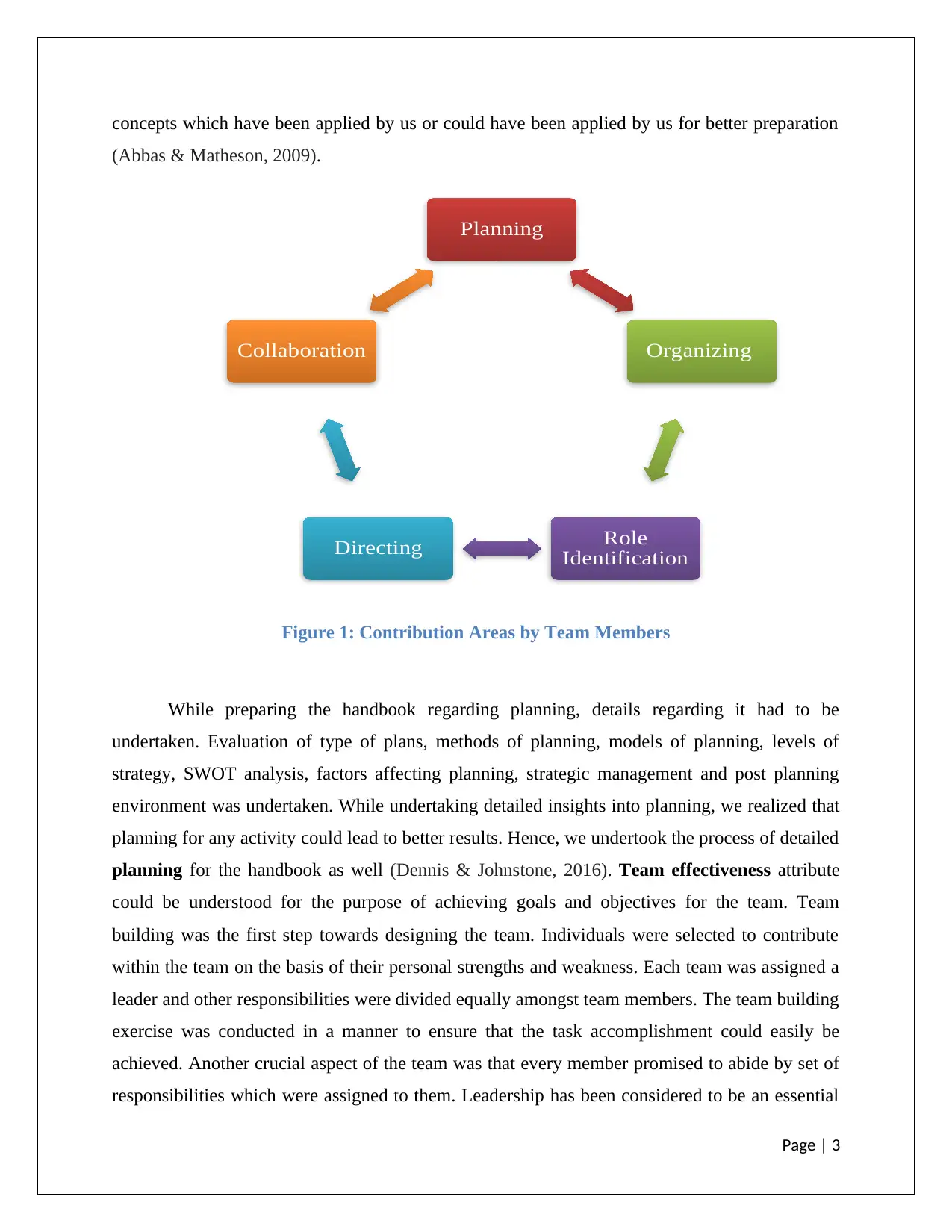
concepts which have been applied by us or could have been applied by us for better preparation
(Abbas & Matheson, 2009).
Figure 1: Contribution Areas by Team Members
While preparing the handbook regarding planning, details regarding it had to be
undertaken. Evaluation of type of plans, methods of planning, models of planning, levels of
strategy, SWOT analysis, factors affecting planning, strategic management and post planning
environment was undertaken. While undertaking detailed insights into planning, we realized that
planning for any activity could lead to better results. Hence, we undertook the process of detailed
planning for the handbook as well (Dennis & Johnstone, 2016). Team effectiveness attribute
could be understood for the purpose of achieving goals and objectives for the team. Team
building was the first step towards designing the team. Individuals were selected to contribute
within the team on the basis of their personal strengths and weakness. Each team was assigned a
leader and other responsibilities were divided equally amongst team members. The team building
exercise was conducted in a manner to ensure that the task accomplishment could easily be
achieved. Another crucial aspect of the team was that every member promised to abide by set of
responsibilities which were assigned to them. Leadership has been considered to be an essential
Page | 3
Planning
Organizing
Role
Identification
Directing
Collaboration
(Abbas & Matheson, 2009).
Figure 1: Contribution Areas by Team Members
While preparing the handbook regarding planning, details regarding it had to be
undertaken. Evaluation of type of plans, methods of planning, models of planning, levels of
strategy, SWOT analysis, factors affecting planning, strategic management and post planning
environment was undertaken. While undertaking detailed insights into planning, we realized that
planning for any activity could lead to better results. Hence, we undertook the process of detailed
planning for the handbook as well (Dennis & Johnstone, 2016). Team effectiveness attribute
could be understood for the purpose of achieving goals and objectives for the team. Team
building was the first step towards designing the team. Individuals were selected to contribute
within the team on the basis of their personal strengths and weakness. Each team was assigned a
leader and other responsibilities were divided equally amongst team members. The team building
exercise was conducted in a manner to ensure that the task accomplishment could easily be
achieved. Another crucial aspect of the team was that every member promised to abide by set of
responsibilities which were assigned to them. Leadership has been considered to be an essential
Page | 3
Planning
Organizing
Role
Identification
Directing
Collaboration
⊘ This is a preview!⊘
Do you want full access?
Subscribe today to unlock all pages.

Trusted by 1+ million students worldwide
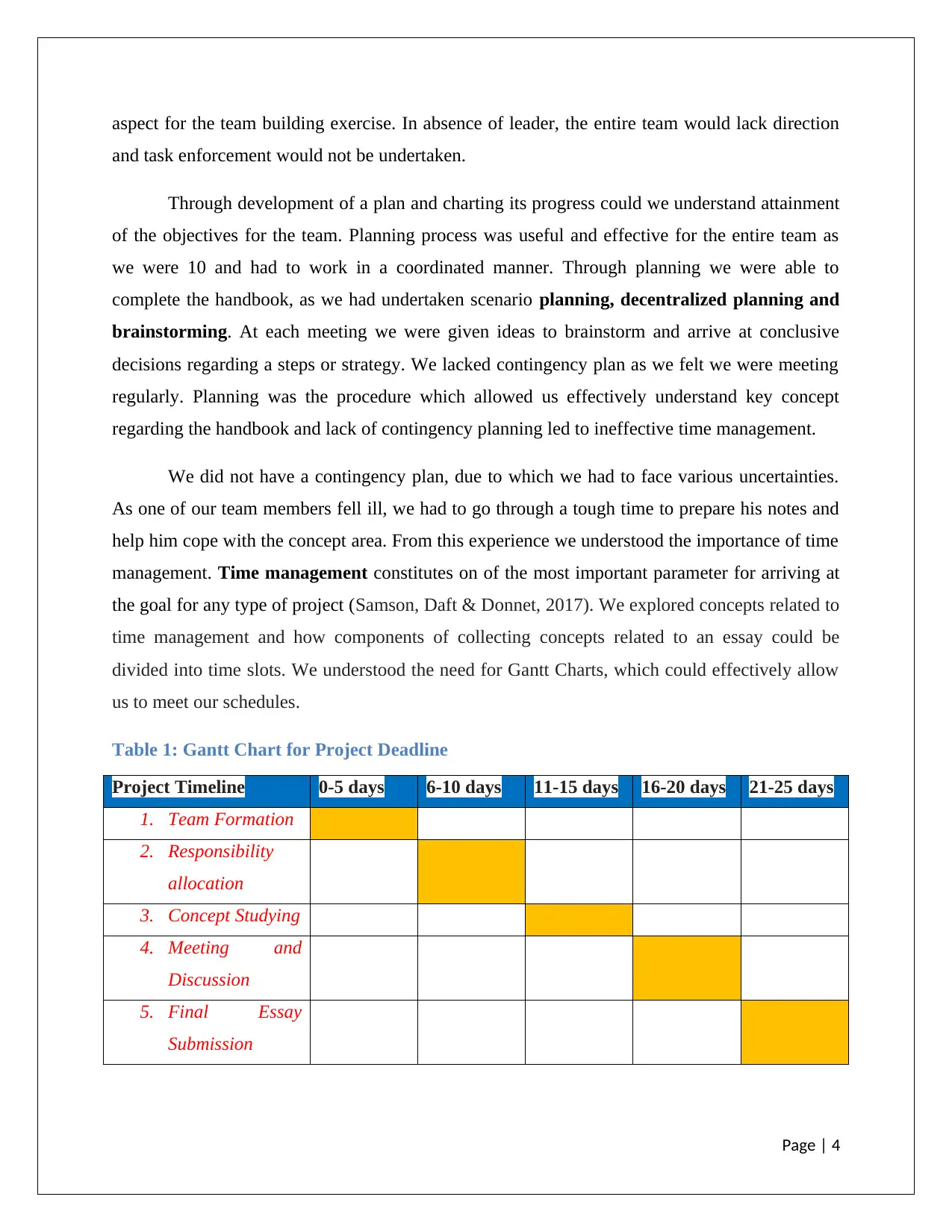
aspect for the team building exercise. In absence of leader, the entire team would lack direction
and task enforcement would not be undertaken.
Through development of a plan and charting its progress could we understand attainment
of the objectives for the team. Planning process was useful and effective for the entire team as
we were 10 and had to work in a coordinated manner. Through planning we were able to
complete the handbook, as we had undertaken scenario planning, decentralized planning and
brainstorming. At each meeting we were given ideas to brainstorm and arrive at conclusive
decisions regarding a steps or strategy. We lacked contingency plan as we felt we were meeting
regularly. Planning was the procedure which allowed us effectively understand key concept
regarding the handbook and lack of contingency planning led to ineffective time management.
We did not have a contingency plan, due to which we had to face various uncertainties.
As one of our team members fell ill, we had to go through a tough time to prepare his notes and
help him cope with the concept area. From this experience we understood the importance of time
management. Time management constitutes on of the most important parameter for arriving at
the goal for any type of project (Samson, Daft & Donnet, 2017). We explored concepts related to
time management and how components of collecting concepts related to an essay could be
divided into time slots. We understood the need for Gantt Charts, which could effectively allow
us to meet our schedules.
Table 1: Gantt Chart for Project Deadline
Project Timeline 0-5 days 6-10 days 11-15 days 16-20 days 21-25 days
1. Team Formation
2. Responsibility
allocation
3. Concept Studying
4. Meeting and
Discussion
5. Final Essay
Submission
Page | 4
and task enforcement would not be undertaken.
Through development of a plan and charting its progress could we understand attainment
of the objectives for the team. Planning process was useful and effective for the entire team as
we were 10 and had to work in a coordinated manner. Through planning we were able to
complete the handbook, as we had undertaken scenario planning, decentralized planning and
brainstorming. At each meeting we were given ideas to brainstorm and arrive at conclusive
decisions regarding a steps or strategy. We lacked contingency plan as we felt we were meeting
regularly. Planning was the procedure which allowed us effectively understand key concept
regarding the handbook and lack of contingency planning led to ineffective time management.
We did not have a contingency plan, due to which we had to face various uncertainties.
As one of our team members fell ill, we had to go through a tough time to prepare his notes and
help him cope with the concept area. From this experience we understood the importance of time
management. Time management constitutes on of the most important parameter for arriving at
the goal for any type of project (Samson, Daft & Donnet, 2017). We explored concepts related to
time management and how components of collecting concepts related to an essay could be
divided into time slots. We understood the need for Gantt Charts, which could effectively allow
us to meet our schedules.
Table 1: Gantt Chart for Project Deadline
Project Timeline 0-5 days 6-10 days 11-15 days 16-20 days 21-25 days
1. Team Formation
2. Responsibility
allocation
3. Concept Studying
4. Meeting and
Discussion
5. Final Essay
Submission
Page | 4
Paraphrase This Document
Need a fresh take? Get an instant paraphrase of this document with our AI Paraphraser
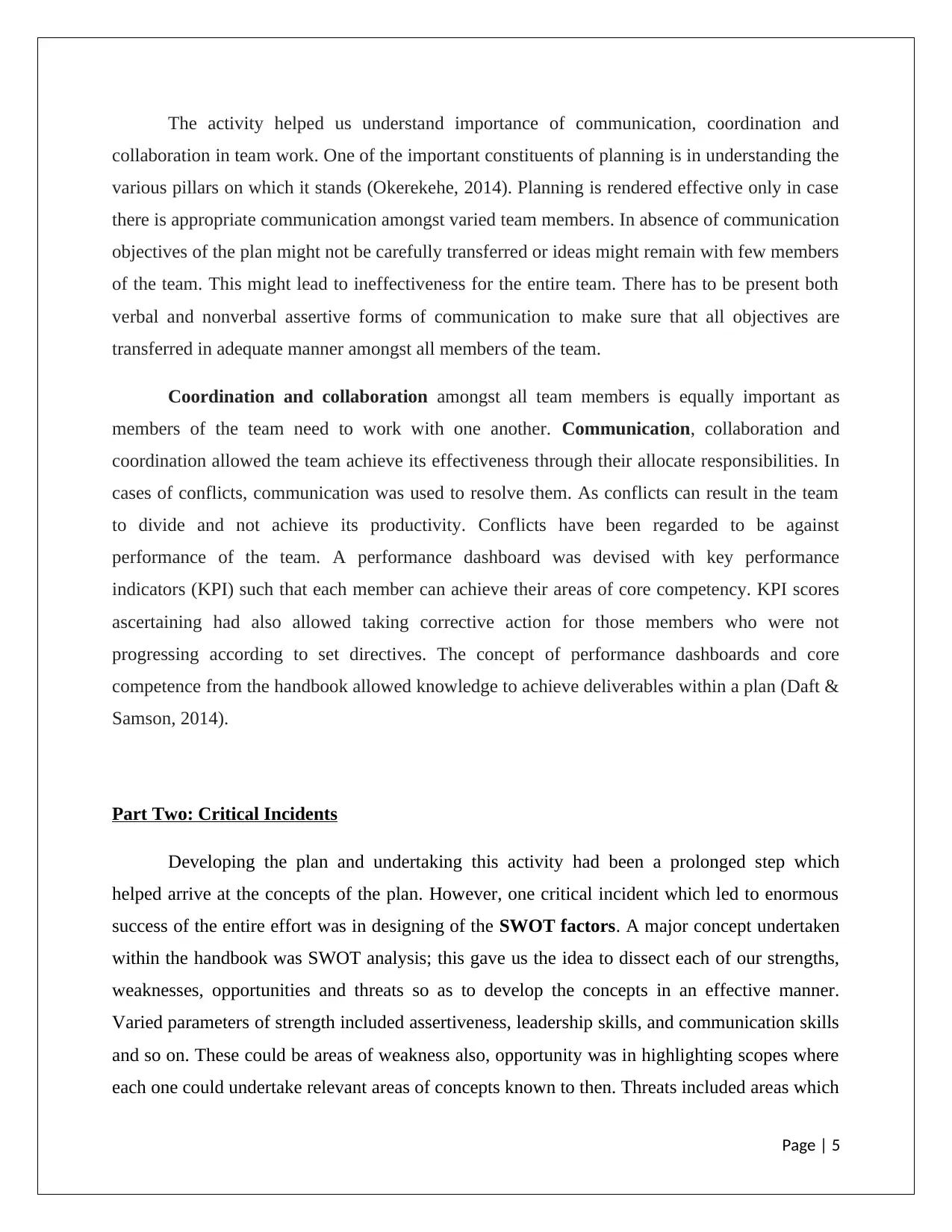
The activity helped us understand importance of communication, coordination and
collaboration in team work. One of the important constituents of planning is in understanding the
various pillars on which it stands (Okerekehe, 2014). Planning is rendered effective only in case
there is appropriate communication amongst varied team members. In absence of communication
objectives of the plan might not be carefully transferred or ideas might remain with few members
of the team. This might lead to ineffectiveness for the entire team. There has to be present both
verbal and nonverbal assertive forms of communication to make sure that all objectives are
transferred in adequate manner amongst all members of the team.
Coordination and collaboration amongst all team members is equally important as
members of the team need to work with one another. Communication, collaboration and
coordination allowed the team achieve its effectiveness through their allocate responsibilities. In
cases of conflicts, communication was used to resolve them. As conflicts can result in the team
to divide and not achieve its productivity. Conflicts have been regarded to be against
performance of the team. A performance dashboard was devised with key performance
indicators (KPI) such that each member can achieve their areas of core competency. KPI scores
ascertaining had also allowed taking corrective action for those members who were not
progressing according to set directives. The concept of performance dashboards and core
competence from the handbook allowed knowledge to achieve deliverables within a plan (Daft &
Samson, 2014).
Part Two: Critical Incidents
Developing the plan and undertaking this activity had been a prolonged step which
helped arrive at the concepts of the plan. However, one critical incident which led to enormous
success of the entire effort was in designing of the SWOT factors. A major concept undertaken
within the handbook was SWOT analysis; this gave us the idea to dissect each of our strengths,
weaknesses, opportunities and threats so as to develop the concepts in an effective manner.
Varied parameters of strength included assertiveness, leadership skills, and communication skills
and so on. These could be areas of weakness also, opportunity was in highlighting scopes where
each one could undertake relevant areas of concepts known to then. Threats included areas which
Page | 5
collaboration in team work. One of the important constituents of planning is in understanding the
various pillars on which it stands (Okerekehe, 2014). Planning is rendered effective only in case
there is appropriate communication amongst varied team members. In absence of communication
objectives of the plan might not be carefully transferred or ideas might remain with few members
of the team. This might lead to ineffectiveness for the entire team. There has to be present both
verbal and nonverbal assertive forms of communication to make sure that all objectives are
transferred in adequate manner amongst all members of the team.
Coordination and collaboration amongst all team members is equally important as
members of the team need to work with one another. Communication, collaboration and
coordination allowed the team achieve its effectiveness through their allocate responsibilities. In
cases of conflicts, communication was used to resolve them. As conflicts can result in the team
to divide and not achieve its productivity. Conflicts have been regarded to be against
performance of the team. A performance dashboard was devised with key performance
indicators (KPI) such that each member can achieve their areas of core competency. KPI scores
ascertaining had also allowed taking corrective action for those members who were not
progressing according to set directives. The concept of performance dashboards and core
competence from the handbook allowed knowledge to achieve deliverables within a plan (Daft &
Samson, 2014).
Part Two: Critical Incidents
Developing the plan and undertaking this activity had been a prolonged step which
helped arrive at the concepts of the plan. However, one critical incident which led to enormous
success of the entire effort was in designing of the SWOT factors. A major concept undertaken
within the handbook was SWOT analysis; this gave us the idea to dissect each of our strengths,
weaknesses, opportunities and threats so as to develop the concepts in an effective manner.
Varied parameters of strength included assertiveness, leadership skills, and communication skills
and so on. These could be areas of weakness also, opportunity was in highlighting scopes where
each one could undertake relevant areas of concepts known to then. Threats included areas which
Page | 5
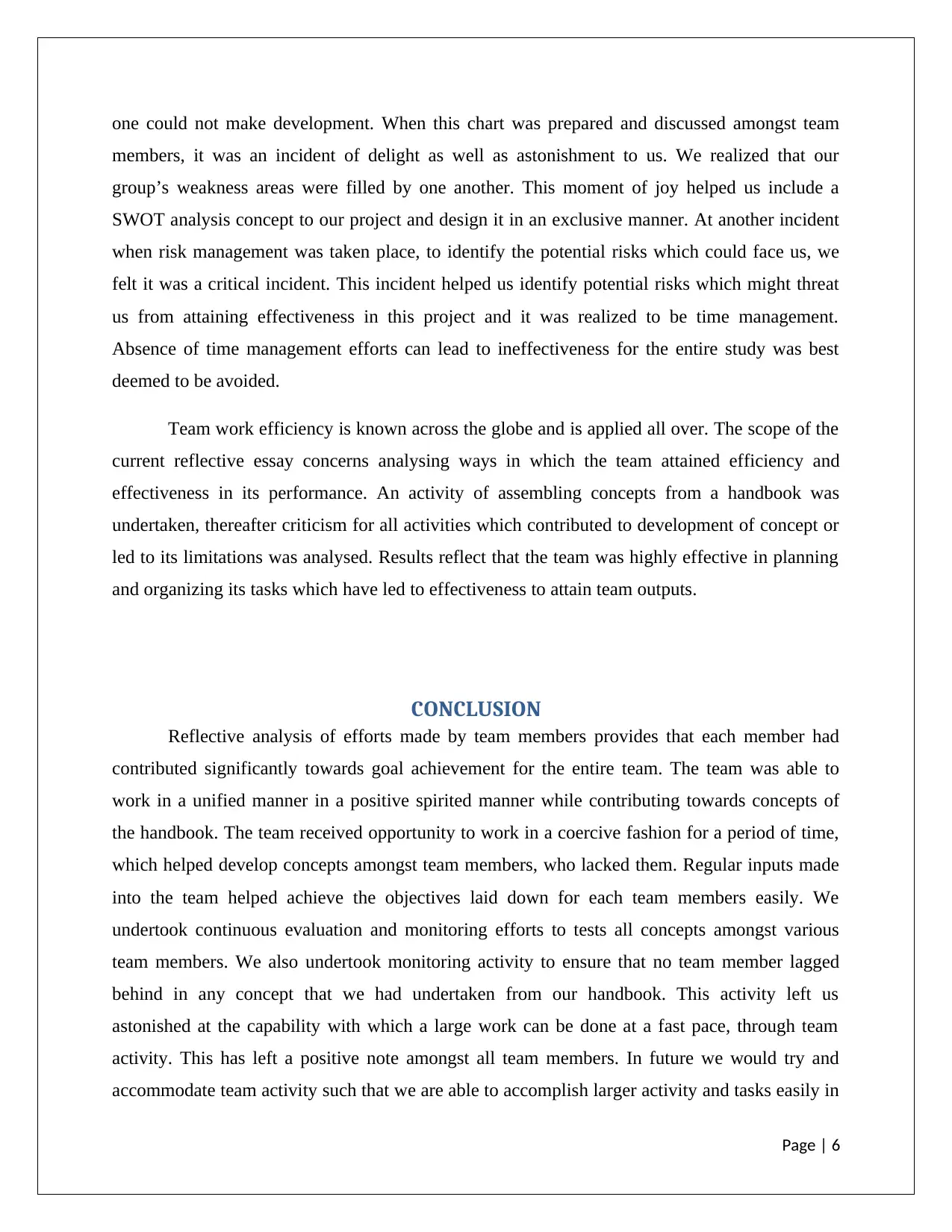
one could not make development. When this chart was prepared and discussed amongst team
members, it was an incident of delight as well as astonishment to us. We realized that our
group’s weakness areas were filled by one another. This moment of joy helped us include a
SWOT analysis concept to our project and design it in an exclusive manner. At another incident
when risk management was taken place, to identify the potential risks which could face us, we
felt it was a critical incident. This incident helped us identify potential risks which might threat
us from attaining effectiveness in this project and it was realized to be time management.
Absence of time management efforts can lead to ineffectiveness for the entire study was best
deemed to be avoided.
Team work efficiency is known across the globe and is applied all over. The scope of the
current reflective essay concerns analysing ways in which the team attained efficiency and
effectiveness in its performance. An activity of assembling concepts from a handbook was
undertaken, thereafter criticism for all activities which contributed to development of concept or
led to its limitations was analysed. Results reflect that the team was highly effective in planning
and organizing its tasks which have led to effectiveness to attain team outputs.
CONCLUSION
Reflective analysis of efforts made by team members provides that each member had
contributed significantly towards goal achievement for the entire team. The team was able to
work in a unified manner in a positive spirited manner while contributing towards concepts of
the handbook. The team received opportunity to work in a coercive fashion for a period of time,
which helped develop concepts amongst team members, who lacked them. Regular inputs made
into the team helped achieve the objectives laid down for each team members easily. We
undertook continuous evaluation and monitoring efforts to tests all concepts amongst various
team members. We also undertook monitoring activity to ensure that no team member lagged
behind in any concept that we had undertaken from our handbook. This activity left us
astonished at the capability with which a large work can be done at a fast pace, through team
activity. This has left a positive note amongst all team members. In future we would try and
accommodate team activity such that we are able to accomplish larger activity and tasks easily in
Page | 6
members, it was an incident of delight as well as astonishment to us. We realized that our
group’s weakness areas were filled by one another. This moment of joy helped us include a
SWOT analysis concept to our project and design it in an exclusive manner. At another incident
when risk management was taken place, to identify the potential risks which could face us, we
felt it was a critical incident. This incident helped us identify potential risks which might threat
us from attaining effectiveness in this project and it was realized to be time management.
Absence of time management efforts can lead to ineffectiveness for the entire study was best
deemed to be avoided.
Team work efficiency is known across the globe and is applied all over. The scope of the
current reflective essay concerns analysing ways in which the team attained efficiency and
effectiveness in its performance. An activity of assembling concepts from a handbook was
undertaken, thereafter criticism for all activities which contributed to development of concept or
led to its limitations was analysed. Results reflect that the team was highly effective in planning
and organizing its tasks which have led to effectiveness to attain team outputs.
CONCLUSION
Reflective analysis of efforts made by team members provides that each member had
contributed significantly towards goal achievement for the entire team. The team was able to
work in a unified manner in a positive spirited manner while contributing towards concepts of
the handbook. The team received opportunity to work in a coercive fashion for a period of time,
which helped develop concepts amongst team members, who lacked them. Regular inputs made
into the team helped achieve the objectives laid down for each team members easily. We
undertook continuous evaluation and monitoring efforts to tests all concepts amongst various
team members. We also undertook monitoring activity to ensure that no team member lagged
behind in any concept that we had undertaken from our handbook. This activity left us
astonished at the capability with which a large work can be done at a fast pace, through team
activity. This has left a positive note amongst all team members. In future we would try and
accommodate team activity such that we are able to accomplish larger activity and tasks easily in
Page | 6
⊘ This is a preview!⊘
Do you want full access?
Subscribe today to unlock all pages.

Trusted by 1+ million students worldwide
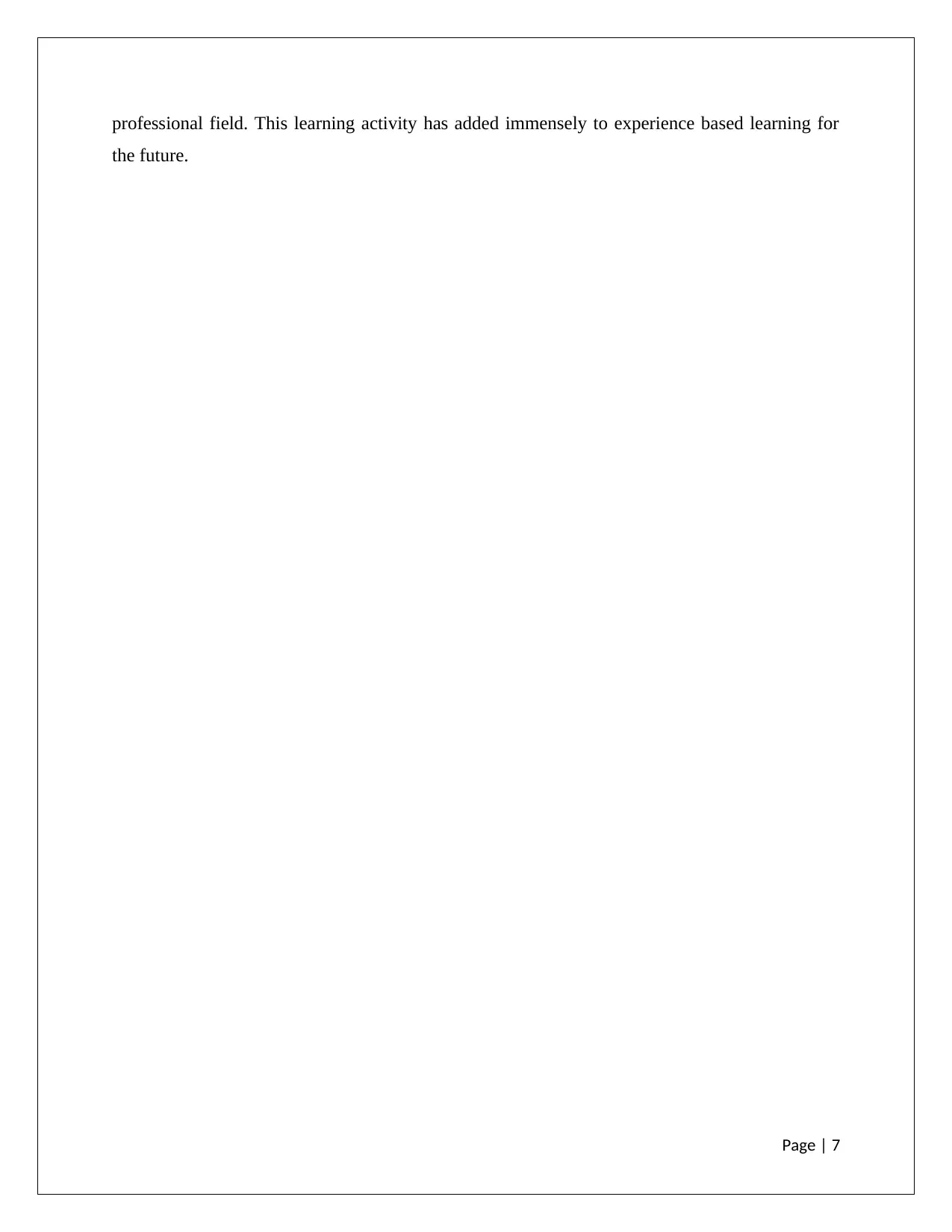
professional field. This learning activity has added immensely to experience based learning for
the future.
Page | 7
the future.
Page | 7
Paraphrase This Document
Need a fresh take? Get an instant paraphrase of this document with our AI Paraphraser
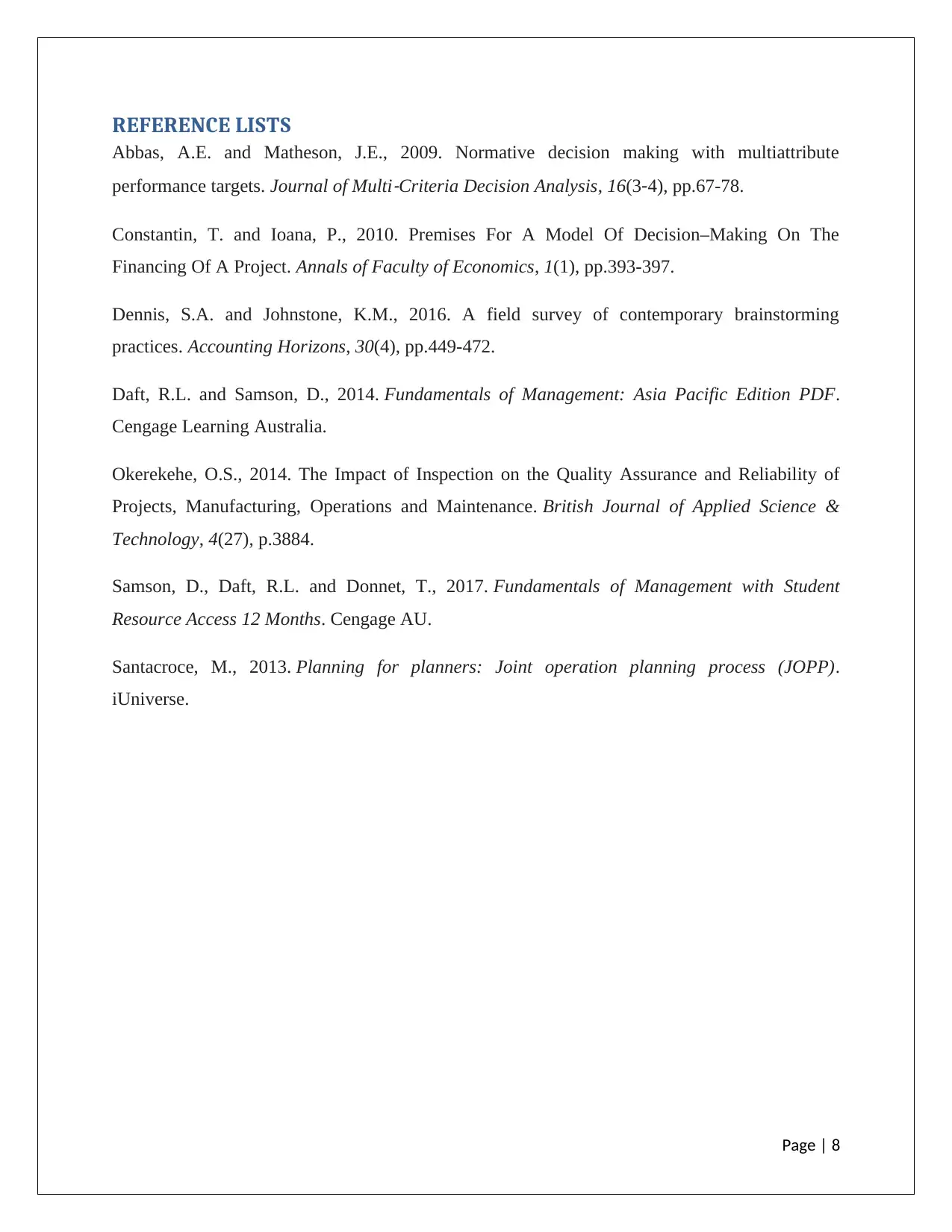
REFERENCE LISTS
Abbas, A.E. and Matheson, J.E., 2009. Normative decision making with multiattribute
performance targets. Journal of Multi
‐Criteria Decision Analysis, 16(3‐4), pp.67-78.
Constantin, T. and Ioana, P., 2010. Premises For A Model Of Decision–Making On The
Financing Of A Project. Annals of Faculty of Economics, 1(1), pp.393-397.
Dennis, S.A. and Johnstone, K.M., 2016. A field survey of contemporary brainstorming
practices. Accounting Horizons, 30(4), pp.449-472.
Daft, R.L. and Samson, D., 2014. Fundamentals of Management: Asia Pacific Edition PDF.
Cengage Learning Australia.
Okerekehe, O.S., 2014. The Impact of Inspection on the Quality Assurance and Reliability of
Projects, Manufacturing, Operations and Maintenance. British Journal of Applied Science &
Technology, 4(27), p.3884.
Samson, D., Daft, R.L. and Donnet, T., 2017. Fundamentals of Management with Student
Resource Access 12 Months. Cengage AU.
Santacroce, M., 2013. Planning for planners: Joint operation planning process (JOPP).
iUniverse.
Page | 8
Abbas, A.E. and Matheson, J.E., 2009. Normative decision making with multiattribute
performance targets. Journal of Multi
‐Criteria Decision Analysis, 16(3‐4), pp.67-78.
Constantin, T. and Ioana, P., 2010. Premises For A Model Of Decision–Making On The
Financing Of A Project. Annals of Faculty of Economics, 1(1), pp.393-397.
Dennis, S.A. and Johnstone, K.M., 2016. A field survey of contemporary brainstorming
practices. Accounting Horizons, 30(4), pp.449-472.
Daft, R.L. and Samson, D., 2014. Fundamentals of Management: Asia Pacific Edition PDF.
Cengage Learning Australia.
Okerekehe, O.S., 2014. The Impact of Inspection on the Quality Assurance and Reliability of
Projects, Manufacturing, Operations and Maintenance. British Journal of Applied Science &
Technology, 4(27), p.3884.
Samson, D., Daft, R.L. and Donnet, T., 2017. Fundamentals of Management with Student
Resource Access 12 Months. Cengage AU.
Santacroce, M., 2013. Planning for planners: Joint operation planning process (JOPP).
iUniverse.
Page | 8
1 out of 8
Related Documents
Your All-in-One AI-Powered Toolkit for Academic Success.
+13062052269
info@desklib.com
Available 24*7 on WhatsApp / Email
![[object Object]](/_next/static/media/star-bottom.7253800d.svg)
Unlock your academic potential
Copyright © 2020–2025 A2Z Services. All Rights Reserved. Developed and managed by ZUCOL.




